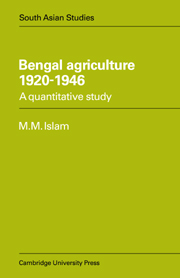Book contents
- Frontmatter
- Contents
- List of tables
- List of figures
- Foreword
- Preface
- Introduction
- PART ONE
- PART TWO
- 4 Price elasticity of acreage under cultivation
- 5 Capital in agriculture
- 6 Agricultural credit and the Co-operative Credit Movement
- 7 Bengal landlords and agriculture
- Conclusion
- Appendix: statistical tables
- Select bibliography
- Index
5 - Capital in agriculture
from PART TWO
Published online by Cambridge University Press: 15 December 2009
- Frontmatter
- Contents
- List of tables
- List of figures
- Foreword
- Preface
- Introduction
- PART ONE
- PART TWO
- 4 Price elasticity of acreage under cultivation
- 5 Capital in agriculture
- 6 Agricultural credit and the Co-operative Credit Movement
- 7 Bengal landlords and agriculture
- Conclusion
- Appendix: statistical tables
- Select bibliography
- Index
Summary
Economic development is generally defined as the sustained growth of per capita output. Among the factors which account for the growth of output a crucial role is usually assigned to capital and capital formation. Theoretically, this dominance of capital theory in the literature on growth economics is partly due to the popularity which the Harrod–Domar model has gained, especially through its application to the economic development of the underdeveloped countries. In this model the rate of economic development is a function of two factors: (a) capital formation and (b) the capital/output ratio; and accordingly development policies have been described as aiming to increase the former, reduce the latter or to achieve both. Much effort has gone into the estimation of the capital/output ratio and the measurement of the contribution of the physical capital stock to past economic growth and the requirements for future progress. Some investigations have shown considerable differences over time in the relation between physical capital and output, but none of them has suggested any ground for doubting the importance of capital formation in economic progress.
Along with this emphasis on the role of capital, another concept which has been widely discussed is that the underdeveloped countries are plagued by a ‘vicious circle’. The circle theory emphasises that since per capita income in these countries is low, little remains as a surplus after consumption needs are fulfilled. The low level of real income is, in turn, due to the lack of an adequate capital stock.
- Type
- Chapter
- Information
- Bengal Agriculture 1920–1946A Quantitative Study, pp. 132 - 156Publisher: Cambridge University PressPrint publication year: 1979



